In this article:
- Step 1: Define Your Brand’s Core Essence (Not Just Mission & Vision)
- Step 2: Craft a Visual Identity That’s Alive (and Evolves)
- Step 3: Design for the Digital Journey, Not Just the Homepage
- Step 4: Build a Content Ecosystem (Not Just a Content Calendar)
- Step 5: Align Your Brand With Human Values and Movements
- Step 6: Create Two-Way Brand Conversations (Not Broadcasts)
- Step 7: Weave Data and Emotion Together
- Step 8: Protect and Nurture Your Digital Reputation
- Step 9: Keep Reinventing Without Losing Your Core
- Final Thoughts on Digital Branding
Jeff Bezos once said, “Your brand is what other people say about you when you’re not in the room.”
Today, that “room” is the internet.
Digital branding is how you shape what they say. It’s the process of building a consistent, emotional, and recognizable identity across every online touchpoint so your audience instantly knows, trusts, and connects with you.
But here’s the catch: digital branding has evolved far beyond logos and taglines.
It’s not just about looking professional. It’s about being felt. The brands that thrive today are the ones that show personality, empathy, and agility in a fast-moving, algorithm-driven world.
In this guide, we’ll walk through 9 fresh, actionable steps to build a digital brand that stands out. Not by shouting louder, but by showing up smarter, truer, and more human.
Step 1: Define Your Brand’s Core Essence (Not Just Mission & Vision)
Before you even touch your logo, color palette, or Instagram grid, pause and ask yourself:

Get 300+ Fonts for FREE
Enter your email to download our 100% free "Font Lover's Bundle". For commercial & personal use. No royalties. No fees. No attribution. 100% free to use anywhere.
What do I want people to feel when they interact with my brand?
That’s your brand’s essence. It’s the invisible heartbeat that drives everything else.
Too often, businesses stop at a “mission statement” that sounds polished but hollow.
“We aim to deliver quality solutions that exceed expectations.”
Okay, but… what does that actually mean to a real human being scrolling through their phone at 11 p.m.?
Your brand essence lives in the emotion behind your purpose. It’s the energetic fingerprint people remember—curiosity, calm, rebellion, empowerment, joy.
For example, Apple’s isn’t “innovation.” It’s freedom through creativity. Nike’s isn’t “sportswear.” It’s personal victory.
Step 2: Craft a Visual Identity That’s Alive (and Evolves)
Gone are the days when your logo and color palette sat still in a brand manual collecting digital dust. Today’s most magnetic brands treat visuals like living organisms that evolve, breathe, and adapt to their environments, just like people do.
Think about it: Spotify’s colors shift with its playlists and moods.
Airbnb’s logo feels different depending on the photos it’s paired with.
Even Google changes its logo every day with doodles that reflect culture and community.
That’s the secret: flexibility with purpose.
Your brand visuals should tell the same story as your words, but in a language of shape, texture, and motion. Experiment with gradients, responsive logos, subtle animations, or photography that actually captures your energy—not just your products.
And here’s the key: don’t lock your visuals in a vault. Let them evolve as your audience does. Brands that cling to outdated visuals end up feeling frozen in time, while those that adapt with intention stay timeless.
Step 3: Design for the Digital Journey, Not Just the Homepage
Most brands obsess over their homepage—the colors, the hero image, the perfect tagline. But here’s the truth: your audience probably won’t meet you there.
They might find you in a TikTok comment thread, a YouTube pre-roll, or a Google snippet.
Maybe it’s an abandoned-cart email or a 2 a.m. chat with your customer support bot.
Every single one of those moments is part of your digital journey, and that journey is your brand.
Your job isn’t to “look good” online. It’s to create a consistent emotional experience across every touchpoint.
Think of your digital presence as a story with multiple chapters—your social media is the introduction, your website is the middle, and your follow-up emails are the epilogue. Each should carry the same mood, tone, and promise.
Want a small but powerful trick? Map out your user’s emotional flow instead of just their clicks.
Ask, how do they feel when they first discover us? When they check out? When they leave a review?
Then design each step to meet that emotion intentionally.
Step 4: Build a Content Ecosystem (Not Just a Content Calendar)
If your brand’s content strategy lives and dies by a monthly calendar, it’s time for an upgrade.
A content calendar helps you post consistently. A content ecosystem helps your brand breathe. It’s the difference between checking off boxes and building something that naturally grows, evolves, and supports itself.
In a healthy ecosystem, every piece of content—whether it’s a blog post, podcast, Instagram Story, or email—connects back to a central narrative. Each one feeds another.
A tweet becomes a Reel. A blog becomes a carousel. A podcast quote becomes a short LinkedIn post that sparks a conversation. Nothing lives in isolation.
Even your testimonials can be recycled to create new, evergreen content. For example, Baumgartner Law Firm doesn’t just share its client testimonials on its homepage. They also have an in-depth “Client Results” page that goes into more detail about the most challenging cases they’ve won.
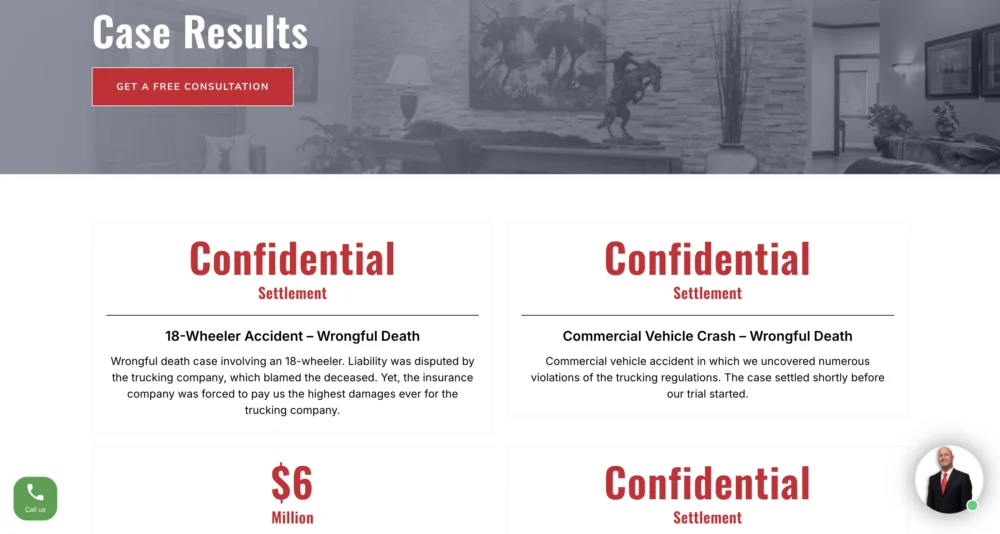
The Law Offices of Robert Wayne Pearce does something similar, using specific, detailed case studies to showcase wins.
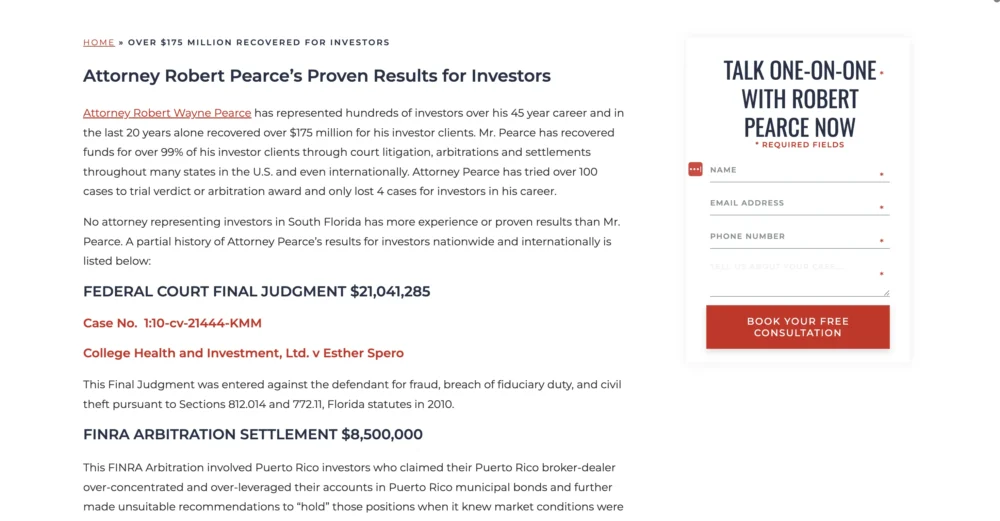
LawRank—a digital marketing agency focused specifically on law firm branding—makes multiple Instagram Reel clips from one podcast episode, multiplying its reach potential while simultaneously generating multiple pieces of cross-channel content from just one recording:
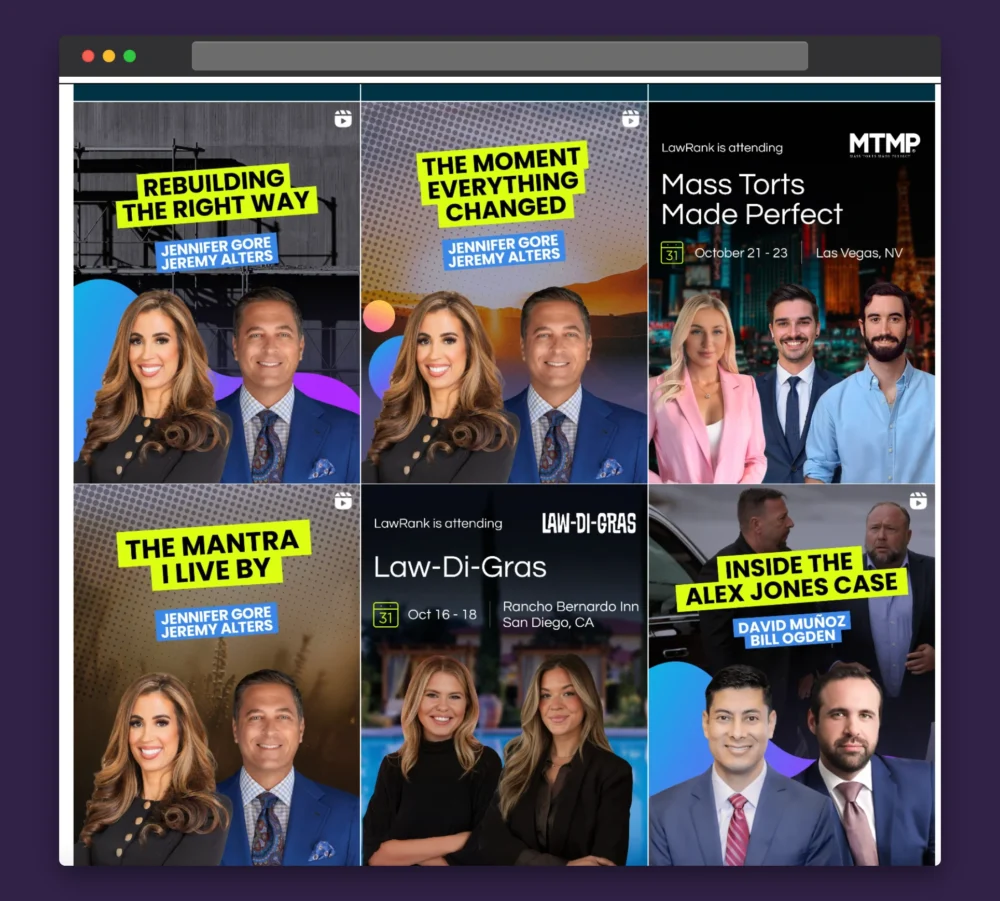
The key is to think modularly. Instead of creating from scratch every time, build reusable “content atoms”—visuals, quotes, themes, data points—that can morph into different formats.
It saves time, keeps your brand storytelling consistent, and lets your brand stay agile without losing authenticity.
And don’t forget the human side of the ecosystem: community-generated content, testimonials, duets, and remixes. When people start adding their voice to yours, that’s when your brand stops being just a company and starts becoming a movement.
Step 5: Align Your Brand With Human Values and Movements
In a world where every brand has a tagline and an ad campaign, the ones that stand out are those that stand for something.
And no, this doesn’t mean you need to jump on every trending hashtag or post a black square once a year. Real alignment means living your values in the small, consistent ways that matter most.
Start by asking: What do we believe in? What are we against?
These aren’t marketing questions—they’re moral ones.
Maybe it’s sustainability, accessibility, mental health, or creative freedom. Whatever your truth is, weave it into your actions, not just your captions.
Patagonia didn’t build its reputation on clever copy. It built it on real-world commitment—donating profits to environmental causes, repairing clothes instead of replacing them, and showing up with integrity every single time.
This can even be as simple as going the extra mile for your potential clients to show them that you really do care. Going back to a law firm example, it’s easy for lawyers to come up with a mission statement. They’re here to provide justice. And they “follow through” on that by just doing their job.
But I was pleasantly surprised to see that, right under their mission statement, Riddle & Riddle Injury Lawyers gives a ton of information to their potential clients to make finding their offices as easy as possible, so they can get the help they need.
They don’t stop at “our mission is to fight for justice and fair compensation for those injured due to someone else’s negligence.” They also give:
- Driving instructions to get to their office
- Parking information
- Public transport information, like bus stops
- Top sights in Goldsboro
- Hotels nearby
- Maps
And more.
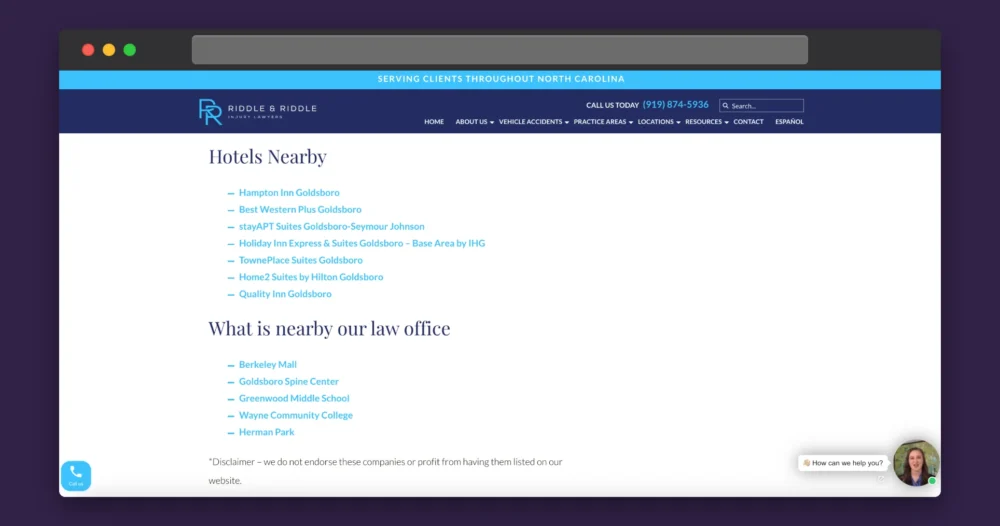
When your audience sees your values in motion—in your packaging, your partnerships, your customer service tone—they start to trust you. And trust is the rarest currency online.
Step 6: Create Two-Way Brand Conversations (Not Broadcasts)
Once upon a time, branding meant shouting the loudest. Now, it’s about listening the closest.
Social media has flipped the script. Audiences don’t want to be “talked at.” They want to be talked with.
If your brand is still treating its platforms like digital billboards, you’re missing the real magic: conversation.
Think of every comment, DM, and tagged story as an open door. When someone interacts with your brand, they’re not looking for a corporate response. They’re looking for a human one.
A laugh. A thank you. A wink. Even a meme. These small moments create emotional intimacy that no paid campaign can buy.
So stop thinking “engagement rate,” and start thinking “relationship rate.”
Ask questions. Run polls. Respond to feedback—not just the glowing kind. Show that there’s a living, breathing personality behind your logo.
Look at how Wendy’s built an empire of brand loyalty with humor, or how Duolingo’s chaotic TikTok energy turned an app into a global conversation. That’s the power of being social on social.
Step 7: Weave Data and Emotion Together
Here’s the truth: the best digital brands don’t choose between data and emotion—they marry them.
It’s easy to fall into one of two camps: the “numbers people” who obsess over analytics dashboards, or the “creatives” who chase inspiration and vibes.
But real digital branding lives in the overlap where human intuition meets measurable insight.
Think of data as a mirror. It doesn’t tell you who you are; it reflects how people are experiencing you. If a particular post gets unusually high saves, ask why. If your email open rate drops, ask what emotion disappeared. Numbers don’t replace storytelling; they guide it.
Netflix is a master of this. Their analytics team knows exactly what triggers curiosity, which emotions make you click “play,” and how to serve content that feels tailor-made without losing the human spark of entertainment.
So yes, track your engagement rate, conversions, retention, all of it. But when you analyze, don’t just look for what’s working—look for what’s moving people.
Because data shows you where your brand is alive, and emotion shows you why.
Step 8: Protect and Nurture Your Digital Reputation
Your digital reputation is like your brand’s heartbeat—invisible, but vital. You don’t always notice it until something goes wrong.
In today’s hyperconnected world, a single review, tweet, or video can shift public perception overnight. That’s why reputation management isn’t just damage control, but daily care.
Start by actively listening to what people say about your brand online.
Use tools like Google Alerts or Mention, sure. But also pay attention to the subtler signal—tone shifts in customer comments, recurring questions, patterns in feedback.
These are emotional breadcrumbs that tell you how your audience feels about you, not just what they think.
When negative feedback surfaces (and it will), resist the instinct to hide or delete. Respond with empathy and accountability. A sincere, human reply can turn a critic into a long-term fan faster than a polished PR statement ever could.
And don’t just wait for good reviews—build them. Celebrate wins publicly, share testimonials, and spotlight your community. Take McMinn Personal Injury Lawyers’ Instagram, for example:
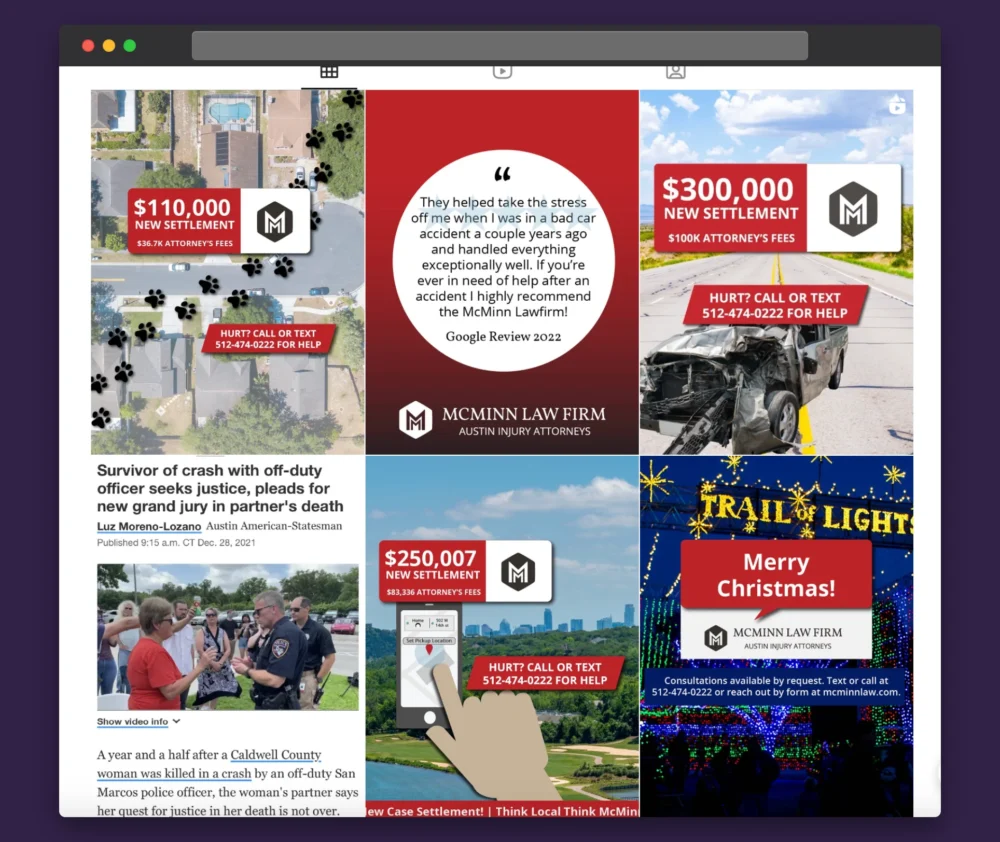
Every positive story becomes part of your brand’s trust bank, protecting you when the storms come.
Your reputation isn’t your marketing. It’s your mirror. Treat it with care.
Step 9: Keep Reinventing Without Losing Your Core
The most successful digital brands know one thing for sure: staying the same is the fastest way to disappear.
But here’s the twist: constant reinvention doesn’t mean throwing everything out the window every six months. It means evolving intentionally.
The goal isn’t to change your essence. It’s to keep finding new ways to express it.
Think of your brand like a musician. The best artists experiment with new sounds, but you can still recognize their voice the second they sing. That’s what you want—evolution without identity loss.
Schedule regular brand “check-ins.” Every few months, review your visuals, messaging, and audience behavior.
What still feels aligned?
What feels outdated?
What needs a refresh?
These mini-adjustments keep your brand relevant and alive without creating confusion or fatigue.
Look at how Mailchimp subtly evolves its colors, illustrations, and tone over time. It’s never jarring, but always fresh. That’s brand longevity in action.
Digital branding isn’t a one-time launch. It’s a lifelong relationship. Keep learning, refining, and reimagining. But never lose sight of the heartbeat that started it all.
Final Thoughts on Digital Branding
Digital branding isn’t about perfection. It’s about connection, whether you’re a local startup, aspiring content creator, lawyer, or Apple.
When your brand speaks with clarity, evolves with purpose, and shows up with genuine humanity, people don’t just remember you—they believe in you.
And in a digital world overflowing with noise, that belief is the most potent brand currency there is.




